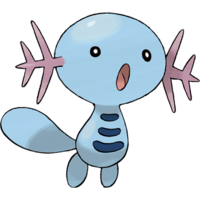On the Origin of Species: Wooper
|
|
Many Pokémon are inspired by real-life creatures. Pokémon evolution, too, is based on real natural phenomena, although it has less in common with genuine evolution than it does with a process called metamorphosis.
We see metamorphosis when a caterpillar turns into a butterfly, and when a tadpole turns into a frog. It means a significant, usually quite rapid change in a creature's appearance that's a necessary part of its life cycle. There's a reason that among the first Pokémon players are likely to catch in the games are the likes of Caterpie and Wurmple: when they evolve, they change in ways familiar to us. They serve as an introduction to the concept of Pokémon evolution by behaving in quite a realistic manner. In contrast to the often fantastical evolutions displayed by species encountered later in the games, a Caterpie becoming a Metapod and then a Butterfree is no different from a caterpillar becoming a cocoon before turning into a butterfly.
So Pokémon evolution can be seen as an exaggerated version of the natural phenomenon of metamorphosis. In real life, many groups of creatures, including mammals and birds, don't ever undergo metamorphosis, but the Pokémon games imagine what it might be like if they could.
There are a few significant differences between Pokémon evolution and metamorphosis, though. In nature, metamorphosis is a necessary part of a creature's life cycle, and until it has fully matured, it won't be able to breed. Tadpoles can't breed; nor can maggots or caterpillars. All of these creatures need to change in order to do this. Pokémon, on the other hand, can happily remain unevolved for as long as the player desires, and (with the exception of 'baby' Pokémon) are able to breed at any evolutionary stage. There are also many Pokémon, like Onix and Skitty, that will remain in their first stage forever unless prompted to evolve by some external factor. Wouldn't it be interesting if creatures like this really existed? Creatures that remained in an immature state for their whole lives, only changing in rare and very specific circumstances?
As it turns out, they do exist. There's even a Pokémon based on them.
Wooper is based on the axolotl (Ambystoma mexicanum), a Mexican salamander with some very unusual traits. They're increasingly common pets in many parts of the world, and in Japan are known as ウーパールーパー, or wooper looper. Most salamanders begin life as purely aquatic creatures, breathing through large, external gills. Then, after a while, they lose their gills and develop lungs. Their bodies become more robust, and they move from the water to the land as fully mature adults. Axolotls are a little different, however. They never lose their gills, or leave the water. They remain in their 'immature' state for their whole lives, though they do mature sexually, and so are fully able to breed. It's easy to see why they're popular as pets: both animals and Pokémon tend to get less cute as they grow, so there's something appealing about an animal that remains in its 'cute' phase for its whole life.
It gets stranger, though. In 1863, a French zoologist by the name of Auguste Duméril received a shipment of axolotls sent from Mexico. Imagine his surprise, then, when he discovered the shipment contained not axolotls, but what seemed to be adult salamanders of an unknown species. Something had happened during transit: the unusual conditions had somehow prompted the axolotls to undergo their long-abandoned process of metamorphosis. A few years later, it was discovered that this process can often be triggered by injecting an axolotl with iodine, though it's not recommended that you try this at home: even if the metamorphosis is successful, the axolotl's life expectancy is significantly shortened as a result.
So, the cheerful, unassuming Wooper has quite a legacy behind it. Given the axolotl's strange life, it's maybe a little disappointing that Wooper evolves much like any other Pokémon does. Nonetheless, it stands as an interesting link between our natural world and the world of Pokémon.
Oh... what's that? You want to know why Wooper doesn't have any arms? Well... there are some things that we just have to put down to artistic license. However, if an axolotl were unfortunate enough to find itself without its front limbs, it wouldn't have to worry for long. Its immature state means that it can regenerate lost body parts, and axolotls also seem to be able to accept transplants from other members of their species with no ill effects. It isn't just pet owners, but also scientists who are interested in the axolotl, the little salamander that's in no hurry to evolve.

